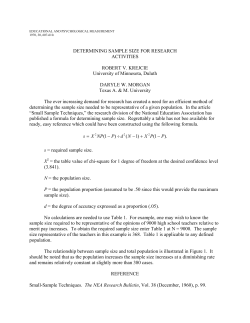
Sample Size Calculation for SRS when Estimating Proportions
Page 1 of 2 Sample Size Calculation when the Sampling Method is Simple Random Sampling (SRS) The following summary addresses two-tailed tests. Sample Size Calculation for SRS when Estimating Proportions When investigating “proportions”, the question being asked must have a "yes/no" or other two-choice answer, leading to a proportion of the population. Examples: o We may wish to estimate the proportion of public secondary educators who will retire within the next 5 years. o We may wish to estimate the proportion of students who receive a passing score on a statewide assessment. o We may wish to estimate the proportion of elementary teachers who are male. o We may wish to estimate the proportion of high school graduates who have completed an online course as part of their high school program of study. o We may wish to estimate the proportion of graduates from a doctoral program who obtain employment as university faculty. o We may wish to estimate the proportion of public school teachers who will change their teaching style to accommodate new educational initiatives, such as the Common Core State Standards. ss = ⁄ ( ) ( ) http://www.surveysystem.com/sample-size-formula.htm Where z = z value for the desired confidence interval: 90% / 1.645 95% / 1.960 99% / 2.575 99.9% / 3.29 p = percentage picking a choice, expressed as decimal Use 0.5 for sample size calculation when proportion in population is unknown. If previous research has shown a valid “p”, then that value may be used in place of 0.5. c = confidence interval, expressed as decimal Determined by researcher (e.g., 0.03 = ±.03) B = bound o The bound is the distance from the mean out to either the upper limit or lower limit of the confidence interval. These limits are referred to as the upper or lower bounds. The bound is the figure that follows the ± sign. o Sample Size Correction for Finite Population (first calculate “ss”, then use correction). ssfp = ss/(1+ (ss-1)/pop) Hypothetical Example: Researchers from a particular state wish to determine the proportion of campers using national forest campgrounds whose camping stay is 5 days or longer. Approximately 99,000 campers use the campgrounds each camping season. Previous studies have shown 43% of camp stays are 5 days or longer. Determine the sample size that researchers must obtain given a desired bound (B) of .02 with a 95% probability. Answer = 2,299 Page 2 of 2 Sample Size Calculation for SRS when Estimating Means Sample size (finite population) when investigating “means”. When investigating “means”, the question being asked is about the average value of a particular quantitative variable for a population. Variables used to calculate sample size: o B = bound The “bound” is half of the confidence interval, it is the numerical distance from the mean out to either the “upper” or “lower” limit. o z = z-score (Where z = z value for the desired confidence interval): 90% / 1.645 95% / 1.960 99% / 2.575 99.9% / 3.29 o = population standard deviation If the population standard deviation is unknown, then one may conduct a pilot/simulation of the study and use the standard deviation from this pilot in place of the population value. o = alpha Typically this is set at .05 for social science research. o N = population size Formula 1: Infinite population size (for infinite or very large populations) o ⁄ ( ) Formula 2: Finite population correction factor (for finite populations) o ( ) Hypothetical Example: Researchers would like to assess the readiness of high school seniors within a large school district to successful obtain and maintain employment. Employability skills will me be measured through the use of a validated workplace skills assessment instrument. There are approximately 1300 seniors within the school district. How many students from the population must be randomly selected in order to be 95 percent sure that the sample mean is within 2 measurement unit of the population mean. A previous survey of high school seniors from another state using the same instrument found the standard deviation of their sample to be 7.25 units on the assessment instrument. Answer = 49
© Copyright 2025





















